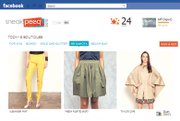Sneakpeeq, Where Shopping Gets Social
San Francisco–based Sneakpeeq has a new take on e-commerce—and social networking. #8232;Described as a “social shopping application on Facebook,” the company provides incentive for repeat visits, brand loyalty and sharing shopping finds with friends.
The site features an assortment of in-season apparel, accessories, cosmetics and gifts from brands including Forever 21, True Religion, Puma, Michael Stars, C.C. Skye and Laura Gellar cosmetics. There are also dedicated brand “boutiques,” including Roxy, Huit Huit, Big Buddha and The Green Bean.
Initial retail prices are listed on Sneakpeeq, but the sale price for each item is not visible until shoppers “peeq” at the price tag. Once they do, they’re given an option to “buy” or “pass.” Each time someone “peeqs,” the price drops. Site founders Henry Kim and Harish Abbott met while in business school at Stanford. Kim went on to work with investor Ron Burkle, while Abbott went on to work at e-commerce giant Amazon.com.
As the two noted the rising importance of social commerce, or social shopping, they began looking for a way to re-create the experience of shopping at a traditional shopping mall.
“We started looking at people’s behavior at malls,” Kim said. “If you walk into a mall and you see something you like, you go over and flip over the price tag. For us, that’s a ’peeq.’”
Once a person has “peeqed” at a price, he or she has the opportunity to “post to the social stream” on Facebook, Kim said, adding, “When you do that, you have the opportunity to bring more people into the ’mall.’”
Sneakpeeq users can browse items and see what their friends are interested in. Or a user—or player—can click on a friend to see all the items she has “peeqed” at.
On Sneakpeeq, prices keep dropping until someone decides to buy. Once an item is sold, the price resets and the game begins again. This continues until inventory on that item is depleted. Inventory levels can range from 40 pieces to 100 pieces for smaller labels to 500 to 750 pieces for bigger brands, Kim said.
“This is using game mechanics,” Kim said. “If you know what the retail price is, it’s not that fun to flip over the price tag. That’s where the game elements come in. That gives it a little bit of a sample-sale mentality. Our consumers are happy—no one ever feels like they’re overpaying—and the brands are happy because they’re getting a lot of engagement on Facebook.” The site is designed so when users check out, they don’t leave the site.
“Our conversion is very good; we’re at a little under 3 percent, and our repeat purchases are at 46 percent,” Kim said.
The game aspect of Sneakpeeq gives users the experience of shopping a sample sale where quantities are small and shoppers get to compete for a good deal. But Kim stressed that Sneakpeeq is different from other sites that sell overstock goods. “We don’t deal with excess inventory—we’re not flash sales,” he said. “As our name suggests, you’re getting a sneak peek into in-season merchandise or merchandise that’s just about to be released.” Kate Spade introduced its Spring collection through Sneakpeeq on the same day the merchandise debuted on Kate Spade’s own site.
To date, the company has signed up more than 400 brands. For now, all the apparel is women’s, but Kim and Abbott plan to eventually add menswear.
“We’re not going to these brands to buy excess inventory; we’re trying to be partners, and we’re partners for the long haul,” Kim said. “Everyone has been very happy with their ’fan’ increases as well as developing their sales channel on a social platform.”
As an example, Kim points to a pilot program conducted with Forever 21 before Sneakpeeq launched. “Initially, they had about 700,000 ’likes.’ Today, they’re over 5 million. True Religion jeans, when we started with them, they were at 18,000 likes. Today they’re over 500,000. We’re not taking credit for every single one of their likes, but we know we had a huge impact. Because across the board, no one has had that sort of Facebook fan growth without advertising—and these guys didn’t advertise.”
The site also offers brands a chance to build their Facebook fan base by offering exclusive merchandise through a “Fan Gate.” On a recent visit, several items from Big Buddha were listed for “Big Buddha fans only.” In order to see the item, visitors have to “like” Big Buddha. #8232;”You can’t put up a Fan Gate for every product, but this is where the game mechanics are,” Kim said. “You can play for products that are open to everyone, but it you want to get an exclusive product, you have to like the brand.”
Kim estimated that 20 percent of Sneakpeeq’s brands are big companies. The company calls them “anchor brands.” The balance is split equally between mid-size companies and emerging brands. Sneakpeeq’s boutiques are live for five to seven days—and then return every four to six weeks. “So you can expect that brand to come back with different merchandise,” Kim explained.
“If you look at how e-commerce has been for the past 10 to 15 years, a lot of it has been highly task-focused and cognitively challenging,” Kim said. “That’s because you have to know what you want and type it into a search. You end up going to the cheapest place that’s a reputable site. That’s not how shopping is done offline and definitely not with apparel. Apparel—a lot of it is discovery. You walk through the racks and something catches your eye, and that’s what we did,” he said.
“At the end of the day, we are a discovery platform on Facebook.”—A.A.N.






















